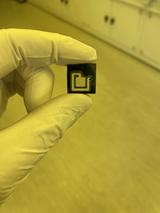Dr James P. McGilligan
Lecturer
Royal Academy of Engineering Research Fellow
Strathclyde Chancellors Fellow
Department of Physics, Strathclyde
- Department of Physics
- University of Strathclyde
- John Anderson, Room 3.08(g)
- Email: james.mcgilligan@strath.ac.uk
- Phone (+44) 141 548 5321 / 5322
- Fax (+44) 141 552 2891
- 107 Rottenrow East
- Glasgow G4 0NG, UK
-
Quantum Technologies
- Atomic clocks
- Atomic magnetometers
- Compact Components

Bio
I did my PhD in the EQOP group at the University of Strathclyde on the development of grating magneto-optical traps as a foundation for a compact, cold-atom clock. Following the completion of my PhD in 2017, I was awarded a Lindemann Fellowship to work at the National Institute of Standards and Technology in Boulder, Colorado in the Atomic Devices, and Instrumentation team. My two-year postdoc focussed on the development of chip-scale cold-atom vacuum cells with simultaneous studies into demonstrating alkali-ion batteries as a viable source of alkali density regulation in portable cold-atom systems.
Following my postdoctoral research, I joined Kelvin Nanotechnology in 2019 as a Quantum Technologist. My position involved managing projects in cold-atom clocks, optically-pumped magnetometers, and micro-fabricated components to aid the miniaturisation of atomic quantum technologies.
I returned to the University of Strathclyde in 2021 as a Royal Academy of Engineering Research Fellow to pursue the micro-fabrication of chip-scale atomic platforms for quantum navigation, covering research topics in atomic clocks and wavelength references with an emphasis on scalable and mass-producible sensors. In 2022, I was appointed as a Chancellors Fellow at the University of Strathclyde.
International Network
Currently I am the principal investigator of the International Network for Micro-fabricated Atomic Quantum Sensors (INMAQS). The INMAQS network is a dedicated platform for global collaboration and technological development that places an emphasis on research fields of Physics and Engineering.
This network brings together international expertise on quantum physics and micro-engineering to oversee the development of next generation miniaturised quantum sensors, specifically for portable atomic clocks and magnetometers. The broad aim is to target the development and integration of diverse technologies, that will raise the technology readiness of quantum sensors and their individual components and ultimately advance our quantum capabilities. With this in mind, we envisage that the technological platform developed within this network will ultimately grow to incorporate a wider range of quantum sensors for electric fields, thermometry, and wavelength referencing.
For more information, please visit inmaqs.ac.uk